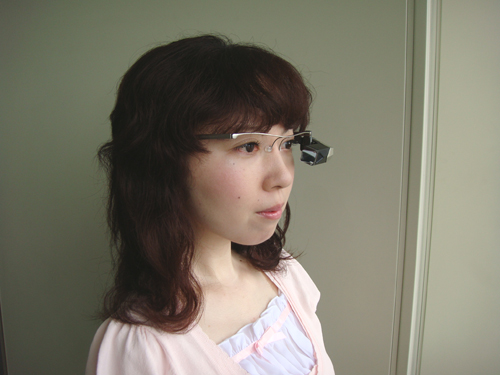Freaky Friday - Nude It
I'm sure that such an application would be a killer-app for augmented reality. "Augmented reality? I'm only using it for the articles". Via @u2elan.
Welcoming our Augmented Future


We installed models of optical / touch sensation into our VCs. It
enables VCs to react for user’s actions to VCs in various and appropriate
ways. For example, they express attention by looking back
when they are hit from backward. They express happiness when
they are stroked gently, and they step away after a strong hit.

One day, you’re sitting in a café reading the news on your phone and you notice that the person next to you has some really nice footwear. No QR code on the neighbor’s shoes? No problem. You start up your visual search application (no, it’s not available on all handsets), act like you are trying to find something on the newsreader screen while you turn off the camera’s “snap the photo” sound, then discreetly aim and take the photo of the shoes. No one has noticed, right? You wait, you act like you’re still reading the news. Your mobile browser opens and on your screen is the exact model of shoes on your neighbor’s feet. Another click and you can check the price and availability from stores nearby.
We are in an age of cartographic awareness unseen in hundreds of years. When was the last time that new mapping tools were sold in chain stores and installed in most vehicles? When was the last time that also the augmentation of maps was done by millions (Google map hacks, etc)? The ubiquitous gps maps run in automobiles while people post pictures and graphic pins to denote specific places on on-line maps.
Conceivably, users could set AR spam filters to block any kind of unpalatable visual information, from political campaign signs to book covers. Parents might want to block sexual or violent images from their kids’ AR systems, and political activists and religious leaders might provide ideologically correct filters for their communities. The bad images get replaced by a red STOP, or perhaps by signs and pictures that reinforce the desired worldview.
Did I mention that the “wrong” people can get replaced too?
Too often, we’ve been seeing AR executions that are AR just for the sake of using AR. Do you really need to launch a video in AR? Or a 3D asset? Too many recent AR executions are guilty of this and scream, “WHY!!!” Why are you making your consumer go through unnecessary hoops when they can just as easily view the video or 3D asset in a standard player on your website? An AR initiative should not be exempt from Best Practices online, so it’s always important to put usability before the ‘experience’.
I've made the source code available in the files section, but there
are some things you should know:
1) Gamaray doesn't use OpenGL, the 3D objects are all rendered in
software. This means the application will never support the kind of
animations or textures found in Layar and Wikitude 3D.
2) Much of the code is not very well thought out and I don't plan on
spending any time explaining it.
3) I don't plan on supporting an open source project, someone else
will need to upload it to a repository and manage the updates.
I would recommend starting fresh and just picking out the useful
tidbits.
Hand from Above from Chris O'Shea on Vimeo.
Wikitude Augmented Reality: WTC - Its not there but its there from Wikitude on Vimeo.
